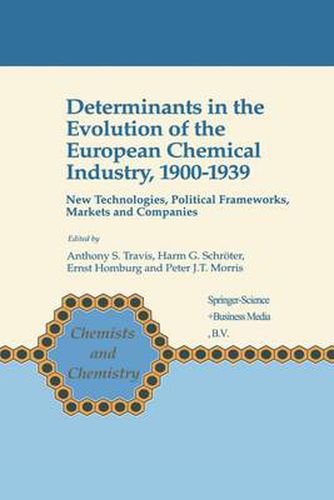Readings Newsletter
Become a Readings Member to make your shopping experience even easier.
Sign in or sign up for free!
You’re not far away from qualifying for FREE standard shipping within Australia
You’ve qualified for FREE standard shipping within Australia
The cart is loading…






This title is printed to order. This book may have been self-published. If so, we cannot guarantee the quality of the content. In the main most books will have gone through the editing process however some may not. We therefore suggest that you be aware of this before ordering this book. If in doubt check either the author or publisher’s details as we are unable to accept any returns unless they are faulty. Please contact us if you have any questions.
This volume represents the proceedings of the European Science Foundation History of Chemistry in Europe 1789-1939 conference held in Strasbourg in October 1996. Leading scholars investigate the ways in which the chemical industry developed throughout much of Europe prior to, and in some cases during, World War II. Emphasis is placed on fertiliser production, which stimulated research into electrochemical and high pressure processes and polymer chemistry. The main focus is on the interwar period, when political strategies for self-sufficiency dictated that innovations were to be based on the availability of raw materials, and the needs of new user industries. Commercial factors also played an important role, particularly the mergers which led to the formation of companies such as IG Farben and Imperial Chemical Industries (ICI). Nevertheless, smaller and independent companies also produced many new products. While much of the European chemical industry was dependent on coal and coal tar products, there were strong moves towards the foundation of science-based biochemical industries. This book is unique in its close examination of technologies, particularly chemical engineering and the control of processes, research in industry, and countries that were not mentioned in previous literature. It is enhanced by contributions from specialists in business and engineering history, as well as by historians of chemistry and technology. Audience: This work will be of great value to historians of chemistry, business, engineering and technology.
$9.00 standard shipping within Australia
FREE standard shipping within Australia for orders over $100.00
Express & International shipping calculated at checkout
This title is printed to order. This book may have been self-published. If so, we cannot guarantee the quality of the content. In the main most books will have gone through the editing process however some may not. We therefore suggest that you be aware of this before ordering this book. If in doubt check either the author or publisher’s details as we are unable to accept any returns unless they are faulty. Please contact us if you have any questions.
This volume represents the proceedings of the European Science Foundation History of Chemistry in Europe 1789-1939 conference held in Strasbourg in October 1996. Leading scholars investigate the ways in which the chemical industry developed throughout much of Europe prior to, and in some cases during, World War II. Emphasis is placed on fertiliser production, which stimulated research into electrochemical and high pressure processes and polymer chemistry. The main focus is on the interwar period, when political strategies for self-sufficiency dictated that innovations were to be based on the availability of raw materials, and the needs of new user industries. Commercial factors also played an important role, particularly the mergers which led to the formation of companies such as IG Farben and Imperial Chemical Industries (ICI). Nevertheless, smaller and independent companies also produced many new products. While much of the European chemical industry was dependent on coal and coal tar products, there were strong moves towards the foundation of science-based biochemical industries. This book is unique in its close examination of technologies, particularly chemical engineering and the control of processes, research in industry, and countries that were not mentioned in previous literature. It is enhanced by contributions from specialists in business and engineering history, as well as by historians of chemistry and technology. Audience: This work will be of great value to historians of chemistry, business, engineering and technology.